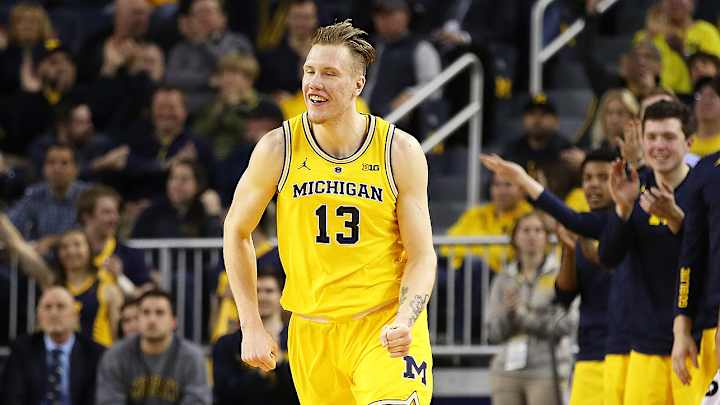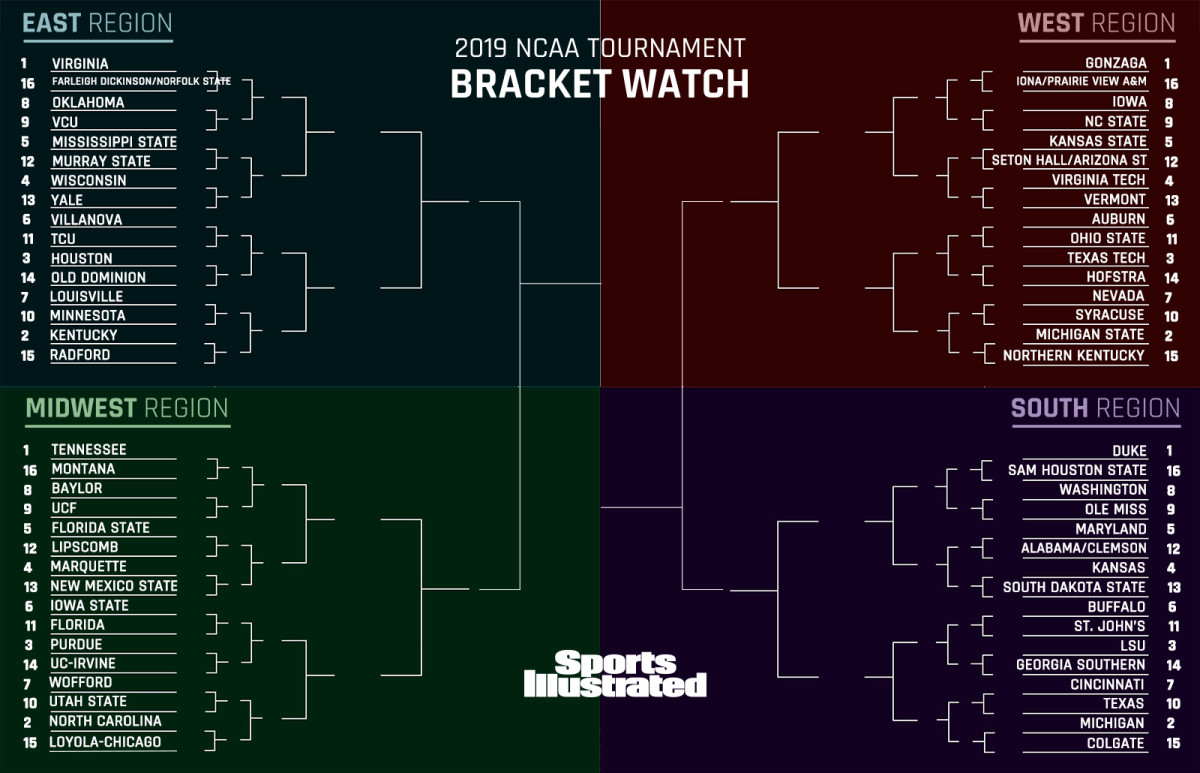Bracket Watch: The Field of 68 Is Getting Sharper, but It's Far From Settled

Smaller conference tournaments begin this week, while the power conferences have one week remaining in the regular season. In two weeks, the field will be set, talk of the bubble will be in the rear-view mirror and everyone you know will be filling out a bracket. It’s hard to believe that so much can still change in that small a window of time, but the field of 68 is far from a finished product. It is, however, starting to come into sharper focus.
Tennessee got back on the top line in this edition of the Bracket Watch after evening the score with Kentucky over the weekend. The major changes, however, took place at the opposite side of the field. UCF and Utah State scored huge wins on Saturday over Houston and Nevada, respectively. Both of those teams, which have been living on the bubble all season, are now in position to get to the dance simply by avoiding bad losses the rest of the way. We also have a new team joining the picture, with Clemson taking the final spot in the field from Temple.
With Selection Sunday just around the corner, we’re going to change how we treat the teams just barely on the wrong side of the bubble. We’ve been going with first eight out and next eight out all season, but there are no longer 16 teams outside the field with realistic at-large hopes. We’ll home in on the ones that are truly still in the hunt by narrowing our scope to first four out and next four out, with another group labeled “still in the mix” that are nothing more than blips on the at-large radar.
Last Four Byes
Ohio State
St. John's
TCU
Florida
Last Four In
Alabama
Seton Hall
Arizona State
Clemson
First Four Out
Temple
Georgetown
Indiana
Furman
Next Four Out
Belmont
Creighton
Memphis
Providence
Still in the Mix
Saint Mary's
Dayton
UNC-Greensboro
Butler
Liberty
East Region
Virginia and Kentucky may seem an unlikely pairing in the same region, but our favorite bracket-building factor could force these two together. That’s right, it’s time for another look at bracketing principles. Virginia, Duke and North Carolina all must be in different regions, and with Virginia Tech and Florida State both possible No. 4 seeds or better, chances are we’ll have one ACC team on one of the top four lines in every region. That limits each of their mobility. Kentucky, meanwhile, has to be separated from both Tennessee and LSU.
The Big Ten plays a role here, too. Michigan, Michigan State and Purdue are almost certainly going to be 4-seeds or better, meaning they all have to be in different regions. Wisconsin is also in line for one of the top-16 overall seeds, and Maryland could play its way back into that picture, as well. In short, the combined dominance of the ACC, SEC and Big Ten at the top of the tournament field means there won’t many options for the committee to piece together the bracket puzzle.
Take our field as it stands. If you want to get Kentucky away from Virginia, it isn’t as simple as just flipping the Wildcats with another No. 2 seed. North Carolina can’t be in Virginia’s region. Moving Michigan or Michigan State there would mean that we have to move Wisconsin out of the East. At the same time, Kentucky can’t move to Tennessee’s or LSU’s region. Strange as it may seem, the dominoes may lead to Virginia and Kentucky being in the same region.
(1) Virginia vs. (16) Fairleigh Dickinson/Norfolk State
(8) Oklahoma vs. (9) VCU
(5) Mississippi State vs. (12) Murray State
(4) Wisconsin vs. (13) Yale
(6) Villanova vs. (11) TCU
(3) Houston vs. (14) Old Dominion
(7) Louisville vs. (10) Minnesota
(2) Kentucky vs. (15) Radford
West Region
The next two weeks could very well make the difference between a first weekend exit from the tournament for Michigan State, or a Final Four run. The Spartans will certainly be without Nick Ward this week, and it’s likely he misses the Big Ten tournament, as well. They host Nebraska and Michigan this week and are already assured a double-bye in the conference tourney by virtue of being one of the top-four seeds. For the sake of conversation, we’ll assume they take care of business against Nebraska, which would lock them into one of the top-three seeds in the conference tournament. Let’s say, though, that they lose to Michigan and lose their first game in Chicago, which would, in this scenario, likely come against Iowa. That could push the Spartans down a seed line in the Big Dance, and there’s a significant difference between being a No. 2 and No. 3 seed. Ward has a realistic chance of returning should the Spartans make the second weekend of the tournament, and once he’s back on the floor there’s no telling what they can do. However, they’d be vulnerable without him as a No. 3 seed, especially in a second-round matchup against the winner of a 6/11 game. The Spartans need at least one more solid win to lock up a No. 2 seed and make their path to the second weekend as easy as possible.
(1) Gonzaga vs. (16) Iona/Prairie View A&M
(8) Iowa vs. (9) NC State
(5) Kansas State vs. (12) Seton Hall/Arizona State
(4) Virginia Tech vs. (13) Vermont
(6) Auburn vs. (11) Ohio State
(3) Texas Tech vs. (14) Hofstra
(7) Nevada vs. (10) Syracuse
(2) Michigan State vs. (15) Northern Kentucky
South Region
Dropping Nevada to a No. 7 seed may seem harsh after its loss at Utah State over the weekend, but no matter how high this team has been ranked for most of the season, it simply doesn’t have a résumé that commands a high seed. The Wolf Pack are ranked 23rd in NET, 24th on kenpom, 21st in Sagarin, and 30th in T-Rank. They’re 1–1 in Q1 games and have a loss outside the top-two quadrants. Their only wins this season over teams on the at-large radar came against Utah State and Arizona State, the former at home and the latter on a neutral floor. We know what the Wolf Pack can do when they’re at their best, but the committee doesn’t evaluate teams like that. They need to look at the hard facts of their entire body of work, and Nevada’s says that it's no more than a No. 7 seed right now.
(1) Duke vs. (16) Sam Houston State
(8) Washington vs. (9) Ole Miss
(5) Maryland vs. (12) Alabama/Clemson
(4) Kansas vs. (13) South Dakota State
(6) Buffalo vs. (11) St. John's
(3) LSU vs. (14) Georgia Southern
(7) Cincinnati vs. (10) Texas
(2) Michigan vs. (15) Colgate
Midwest Region
The committee doesn’t set out to create purposely fun regions, but how great would our projected Midwest Region be? Tennessee, North Carolina and Purdue, the region’s top-three teams, are ranked third, sixth and fifth, respectively, in kenpom’s adjusted offensive efficiency. Marquette, the No. 4 seed, has slipped a bit in overall efficiency, but is still seventh in the country in three-point percentage. Then there’s Florida State, an elite defensive team with a ton of athleticism; Iowa State, which is ranked ninth in adjusted offensive efficiency; Wofford, this season’s mid-major powerhouse that is ranked 14th in NET and is 10th in adjusted offensive efficiency; Baylor, which nearly won the Big 12 despite seven of its nine rotation players logging zero minutes for the team last year; and Syracuse, a high-ceiling squad with wins over Duke and Louisville. Admiral Schofield, Grant Williams, Luke Maye, Coby White, Carsen Edwards, Markus Howard, Terance Mann, Trent Forrest, Marial Shayok, Nick Weiler-Babb and Fletcher Magee all sharing the same region? Yes, please.
(1) Tennessee vs. (16) Montana
(8) Baylor vs. (9) UCF
(5) Florida State vs. (12) Lipscomb
(4) Marquette vs. (13) New Mexico State
(6) Iowa State vs. (11) Florida
(3) Purdue vs. (14) UC-Irvine
(7) Wofford vs. (10) Utah State
(2) North Carolina vs. (15) Loyola-Chicago
Full SI.com NCAA Tournament Bracket Watch (as of March 6)

